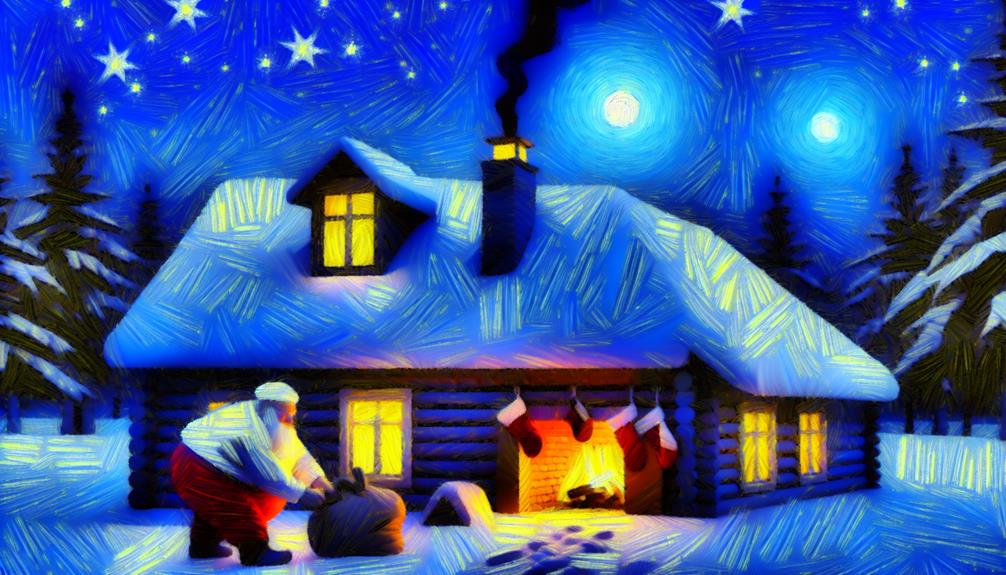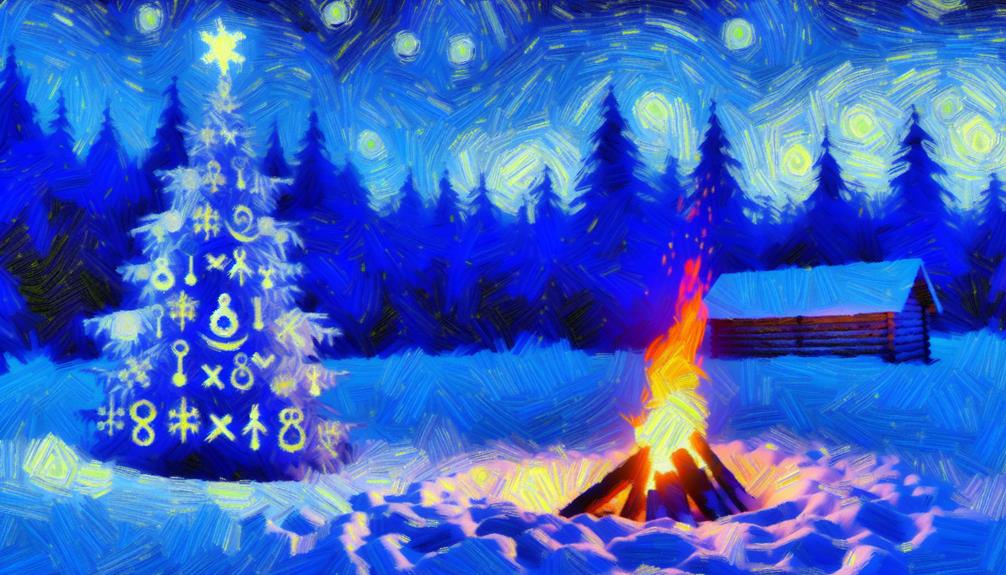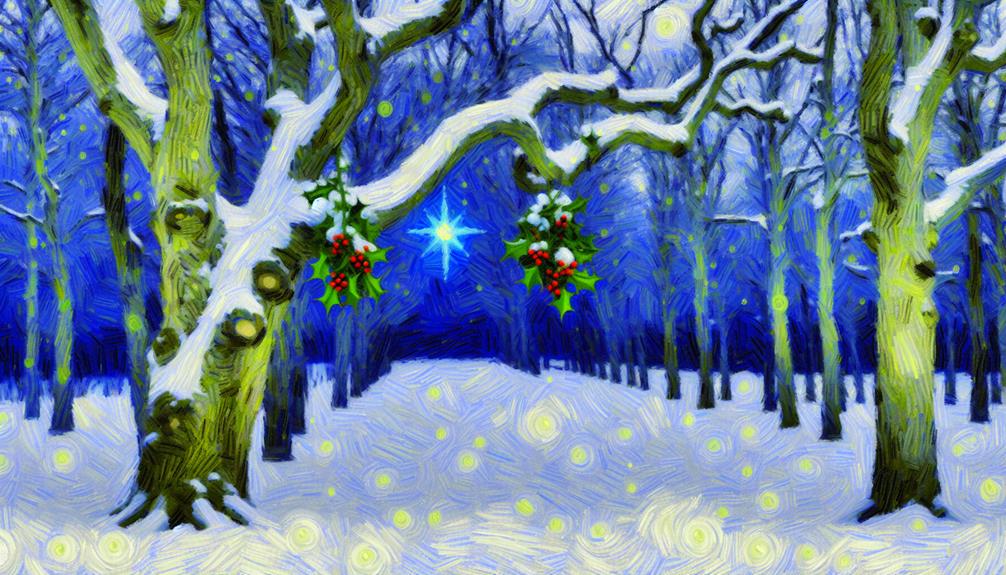Many beloved Christmas traditions trace their roots back to ancient pagan celebrations. Decorating Christmas trees and burning Yule logs began with winter solstice festivities, symbolizing life, light, and renewal. Gift-giving hails from Saturnalia, a Roman festival full of joyous revelry and exchanges. Even mistletoe’s charming kissing custom originates from Druid and Norse myths of luck and love. Santa Claus, filling stockings with gifts, merges St. Nicholas with Yule traditions of offering treats. These fascinating customs, steeped in history, transformed over centuries into the festive elements of Christmas, making the holiday an enchanting blend of diverse cultural practices. Curious for more?
Takeaways
- Decorating Christmas trees originates from ancient pagan traditions celebrating the winter solstice with evergreen trees symbolizing eternal life.
- The practice of burning Yule logs comes from Norse rituals marking the winter solstice and symbolizes light’s return and renewal.
- Gift-giving during Christmas has roots in the Roman festival Saturnalia, which involved joyous gift exchanges to symbolize luck and prosperity.
- Mistletoe and holly used in Christmas decorations were considered sacred by Druids and Romans, symbolizing fertility, protection, and good luck.
Pagan Origins of Christmas
Many Christmas traditions have their origins in ancient pagan festivals and rituals. The festive spirit of Christmas, filled with gift-giving and merrymaking, finds its roots in the Roman festival of Saturnalia. Saturnalia, celebrated in honor of the god Saturn, was a time of joyous revelry and social reversals, much like our modern holiday season.
The Christmas tree, a centerpiece of holiday decor, also has pagan origins. Ancient cultures, including the Germanic tribes who worshipped Odin, used evergreen trees to symbolize eternal life during the solstice. This tradition evolved into the decorated Christmas trees we cherish today.
Mistletoe, a beloved Christmas decoration, was considered sacred by the ancient Celts and Norse. This plant was believed to bring good luck and fertility, which led to the charming custom of kissing under the mistletoe.
The Yule log, another significant element, comes from the Norse Yule festival. It symbolizes warmth and the return of the sun, influencing our Christmas customs related to fire and light.
Winter Solstice Celebrations

Winter solstice celebrations, steeped in history and tradition, marked the shortest day of the year for various ancient pagan cultures. These festivities were a time for rest, worship, and feasting after the harvest season, embodying the essence of pagan traditions. Many ancient civilizations, such as those in ancient Rome and among the Celts, hosted grand festivals to honor deities and celebrate the return of light, which greatly influenced early Christmas traditions.
In ancient Rome, the winter solstice was celebrated with the Roman festival called Saturnalia. This festival included festive gatherings, singing, dancing, and exchanging gifts, practices that would later become integral to Christmas traditions. People believed that these activities brought good luck and prosperity for the coming year.
Below is a table illustrating key elements of winter solstice celebrations:
| Aspect | Ancient Practice | Christmas Tradition |
|---|---|---|
| Exchanging Gifts | Part of Saturnalia | Modern Christmas gifting |
| Festive Gatherings | Communal feasts and dances | Family and social events |
| Holy Plant | Mistletoe for fertility | Mistletoe decorations |
These pre-Christian traditions, emphasizing hope and renewal, seamlessly converted into the Christmas celebrations we recognize today, blending ancient customs with new religious significance.
Gift-Giving Traditions
Gift-giving during Christmas has fascinating roots in the Roman festival of Saturnalia, where people exchanged gifts to spread luck and joy.
Early Christians saw the value in this tradition and made it their own, using gift-giving to symbolize goodwill and prosperity.
These ancient customs, combined with the biblical story of the Magi bringing gifts to baby Jesus, have shaped the festive generosity we cherish today.
Saturnalia Gift Exchanges
Saturnalia, a Roman festival celebrated from December 17 to 24, featured vibrant gift exchanges that symbolized good luck and prosperity, a tradition that would later influence Christmas customs.
During Saturnalia, Romans indulged in feasting and merriment, embracing a sense of goodwill and community spirit. Gift exchanges were a central part of this joyous celebration, with items such as candles, figurines, and food commonly given. These gifts were not only tokens of appreciation but also symbols meant to bring prosperity and fortune to the recipients.
The Romans believed that these acts of generosity fostered stronger community bonds and enhanced the festive atmosphere. The tradition of giving gifts during Christmas can be traced back to these Saturnalian customs, highlighting the enduring influence of this ancient festival on modern holiday practices.
The spirit of Saturnalia, characterized by laughter, generosity, and unity, laid the groundwork for the way we celebrate Christmas today. This festive season, marked by the exchange of gifts, is a demonstration of how ancient traditions can shape and enrich contemporary customs, reminding us of the timeless values of kindness and community.
Early Christian Adoption
Early Christians integrated the tradition of exchanging gifts from the Roman festival of Saturnalia into their own celebrations, thereby establishing a custom that would become central to Christmas festivities. Saturnalia, a week-long festival held from December 17 to 24, was filled with joy, celebrations, and the exchanging of gifts as symbols of goodwill and prosperity.
Early Christians saw an opportunity to blend these pagan customs with their own beliefs, enriching their traditions with elements of joy and generosity.
The practice of gift-giving during Christmas also reflects the story of the Magi, the wise men who brought precious gifts to the infant Jesus. This connection gave the tradition a deeply symbolic Christian layer while maintaining its roots in Saturnalia’s festive spirit.
By adopting gift-giving, early Christians fostered a sense of community and strengthened family ties, emphasizing the importance of goodwill and togetherness.
Today’s Christmas gift-giving customs still carry the influence of these early Christian adaptations of pagan practices. The joy of giving and receiving gifts continues to embody the essence of community and family, intertwining ancient traditions with the warmth and spirit of the Christmas season.
Santa Claus and Stockings

Blending elements from various cultural traditions, the figure of Santa Claus and the custom of hanging stockings reflect a rich fabric of historical influences. The modern Santa Claus owes his existence to a mix of figures, including St. Nicholas, the Norse god Odin, and a bit of clever marketing from Coca-Cola.
The tradition of children leaving stockings or boots out for Santa to fill with gifts is rooted in pagan traditions. During Yule festivities, children would leave footwear for Odin, hoping for treats in return.
The act of hanging stockings by the fireplace comes from Dutch customs where children would hang their shoes for St. Nicholas to fill with treats. This practice evolved into the modern stocking tradition that is understood today.
Santa Claus’s association with gift-giving aligns with the ancient customs of exchanging gifts during Saturnalia, a Roman festival that celebrated abundance and merrymaking.
Filling stockings with gifts also echoes earlier pagan customs of leaving offerings for deities during winter celebrations. These acts symbolized goodwill and prosperity, helping people through the darkest season of the year.
Each of these elements combines to create the beloved holiday traditions that are cherished today.
Christmas Tree and Yule Log

The tradition of decorating Christmas trees and burning Yule logs has roots in ancient pagan practices that honored the winter solstice.
Ancient Germanic tribes celebrated by bringing evergreen trees indoors, while Romans adorned their homes with fir trees during Saturnalia.
The Yule log, burned for warmth and good luck, symbolizes the return of light, intertwining these customs with Christian celebrations that emphasize renewal and hope.
Ancient Tree Decorations
Ancient traditions of decorating evergreen trees and burning Yule logs during winter solstice celebrations laid the foundation for many modern Christmas customs.
These ancient practices have deep roots in pagan traditions. Evergreen trees, particularly firs, were symbols of eternal life, brought indoors to add brightness during the dark winter months. Early Germanic tribes, for instance, honored the god Odin by adorning trees with offerings during the Yule festival, directly influencing the Christmas tree that we understand today.
The Romans also played a part in shaping these traditions. During Saturnalia, a lively festival celebrating merriment and social reversal, they decorated trees with metal ornaments. This practice of tree decorations, deeply embedded in pagan celebrations, eventually found its way into Christmas festivities as early Christians incorporated these rituals, transforming them into a widely accepted symbol of the holiday season.
The Yule log, another significant symbol, was burned to welcome the return of the sun, representing warmth and light during the cold season.
These ancient tree decorations and customs, from Odin’s offerings to Saturnalia’s ornaments, have evolved yet continue to brighten our homes and hearts during Christmas.
Yule Log Rituals
Rooted in ancient Norse traditions, Yule log rituals historically involved burning a specially chosen log in the hearth to mark the winter solstice and welcome the return of the sun. During these cold and dark months, the Yule log served as a beacon of hope and warmth, symbolizing the triumph of light over darkness.
In ancient Norse culture, the Yule log was often connected to the god Freyr, with its ashes believed to bring good luck and fertility. This practice, rich in symbolism, was a way to honor pagan deities and guarantee protection through the harsh winter. The burning of the Yule log was more than just a fire; it was a ritual that gathered families together, fostering a sense of community and shared purpose.
Similarly, the tradition of decorating evergreen trees can be traced back to the ancient Germanic tribes. These tribes would adorn trees with offerings to honor their pagan gods during the winter solstice. Evergreen trees, which remain vibrant throughout the year, symbolized eternal life and resilience.
Over time, these Yule log rituals and the practice of bringing evergreens indoors evolved, blending into the festive customs we associate with modern Christmas celebrations today.
Evergreens and Paganism
Evergreen traditions, deeply embedded in pagan practices, highlight the symbolic significance of eternal life through the use of fir trees and Yule logs during winter festivities. From the Romans to early Germanic tribes, evergreens played a pivotal role in celebrating the winter solstice and honoring pagan gods. These customs, steeped in rich history, later influenced the modern Christmas tree and Yule log traditions that are recognized today.
Evergreens were brought indoors to brighten homes and represent life that endures through harsh winters. Early Germanic tribes decorated trees to honor gods like Odin, intertwining evergreens with the sacred. The Yule log, a cornerstone of Yule celebrations, was burned to welcome the winter solstice, symbolizing warmth and protection.
Romans also embraced evergreens during Saturnalia, decorating their homes with fir branches. This practice, along with other pagan traditions, was gradually adapted by the early Church, transforming evergreen decorations into Christian traditions to make Christmas more appealing to non-Christians.
- Evergreens: Symbolize eternal life, used by various cultures.
- Yule log: Burned to celebrate the winter solstice.
- Decorating trees: A tribute to pagan gods.
- Saturnalia: Roman festival featuring evergreens.
These fascinating transformations illustrate how ancient traditions continue to influence our holiday celebrations.
Mistletoe and Holly

Mistletoe and holly, both revered in pagan traditions, carry rich histories of mystical powers and seasonal symbolism that have seamlessly integrated into Christmas customs.
Mistletoe, considered a sacred plant by the Druids in ancient Britain, was believed to cure diseases and bring good luck. In pagan cultures, it was often used in fertility rituals, and the ancient Romans celebrated its significance during the winter solstice. The tradition of kissing under mistletoe may have roots in Norse myths, where it symbolized love and peace, particularly in the story of the god Balder.
Holly, too, was sacred to pagan cultures, symbolizing fertility and protection during winter solstice celebrations. This evergreen plant was believed to ward off evil spirits and bring prosperity. Holly’s sharp leaves and bright red berries were seen as a barrier against dark forces, making it a popular choice for decorations.
Both mistletoe and holly found their way into Christmas traditions as decorations, reflecting their ancient significance. Mistletoe is often hung in doorways, inviting kisses and spreading good cheer, while holly is used to adorn homes, echoing its role as a protector and symbol of fertility.
Evolution of Christmas Celebrations

The evolution of Christmas celebrations is a complex fabric woven from pagan traditions, early Christian adaptations, and modern commercial influences.
In the 4th century CE, Christmas was strategically aligned with the winter solstice to attract more followers. This alignment allowed early Christians to incorporate popular pagan customs, making the holiday more relatable. Key elements from pagan festivals like Saturnalia and Yule—such as gift-giving, feasting, and merriment—were adopted to enhance the celebration’s appeal.
Modern Christmas customs have evolved considerably over time. For example, tree decoration, a practice with roots in Yule celebrations, has become a staple of holiday decor. The image of Santa Claus, a global symbol of Christmas, draws from various historical and mythical sources, including pagan traditions, transforming over centuries into the jolly figure we recognize today.
The commercialization of Christmas began in the 19th century with the rise of Christmas cards and the widespread practice of gift-giving. These changes reflect the blending of diverse cultural practices, shaping the holiday as we acknowledge it today.
- Winter solstice alignment
- Adoption of Saturnalia and Yule traditions
- 19th-century commercialization
- Evolution of tree decoration
Understanding these layers helps us appreciate the rich mosaic of Christmas traditions.
Frequently Asked Questions
Is December 25 a Pagan Holiday?
December 25 is not inherently a pagan holiday, but its selection for Christmas aligns with several pre-existing pagan festivals, such as Sol Invictus and Saturnalia. This strategic choice facilitated the conversion of non-Christians to Christianity.
Is Christmas a Biblical or Pagan Bible Verse?
The Bible does not specify December 25th as the birthdate of Jesus. While Christmas incorporates elements from pagan traditions, its primary focus is on celebrating the nativity of Jesus, which is rooted in Christian theology.
Are Christmas Lights Pagan Origin?
Christmas lights have a pagan origin, symbolizing the triumph of light over darkness. Ancient Romans used candles during Saturnalia, and early Christians adopted this practice to signify hope and renewal, reflecting earlier pagan traditions.
What Does the Bible Say About Pagan Holidays?
The Bible does not specifically address pagan holidays. However, it advises against adopting pagan customs (Jeremiah 10:2-4) and emphasizes worshiping God in spirit and truth (John 4:24), suggesting avoidance of practices rooted in paganism.
Conclusion
The enchanting customs of Christmas, such as the Christmas tree, mistletoe, and even Santa Claus, have deep roots in ancient pagan traditions.
These elements, adapted over centuries, connect modern celebrations with winter solstice festivities of old.
Understanding these origins enriches the holiday experience, offering a glimpse into how cultures blend and evolve.
This fascinating journey through time reveals how the magic of Christmas has been shaped by diverse historical influences, making the season even more special.













